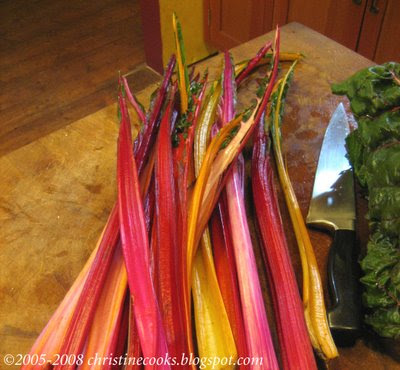Ever heard of Yacón? Neither had I until a few weeks ago. Farmers market supplier, Jacques Neukom had a display of what looked like potatoes, or maybe a new strain of Jerusalem artichoke, it was hard to tell. As it turns out, they were tubers that grow high in the Andes Mountains of Peru and are distantly related to sunflowers.
Botanically named Smallanthus sonchifolius, Yacón has a taste that's a bit like a crunchy sunchoke or a water chestnut, with a wonderfully juicy sweetness. It can be eaten raw, sautéed in stir fries, or roasted with other root vegetables. Because this Yacón is grown organically and locally, we're going to use it as a substitute for water chestnuts in this year's Thanksgiving stuffing. A colorful dish like the one offered here wouldn't be a bad idea either.
The sugars in Yacón seem to have a low impact on diabetics and studies are currently underway to determine just what the long term health benefits may be and how the food industry might capitalize on these low glycemic sugars.
For now, I'm happy to put them into stir fries, such as this offering of rainbow chard stalks, a mix of homegrown peppers, farmers market onion and garlic. A little kosher salt, a small amount of freshly ground black pepper, and a sprinkle or two of golden balsamic vinegar finishes this dish. No further embellishments needed.
Remember when I admonished you to not toss out your chard stalks? With good reason. First, what a great waste! Second, chard is listed as one of the world's healthiest foods and its stalks are very, very good for you as well, and they are in season right now. So, c'mon, put a little green, yellow, pink, red and orange in your life and on your plate.

Christine's Stir Fried Chard Stalks with Peppers and Yacón
Christine's original recipe
Ingredients:
22 rainbow chard stalks, ends trimmed, cut crosswise into 1-inch pieces
4-5 garden peppers of any sweet kind, chopped (You can throw in a jalapeno if that suits you)
2 medium Yacón tubers, peeled and diced
1 medium onion, medium dice
2-3 garlic cloves, minced
Olive oil for the pan
Preparation:
Heat the oil in a heavy skillet over medium high. Add the minced garlic and onions and saute until softened.
Add the peppers and chard stalks and saute for about 3 minutes more.
Add the Yacón, stirring it into the rest of the vegetables, reduce the heat to medium low and allow to cook until everything is nicely tender, about 10 minutes more.
Don't overcook or you will loose the beautiful colors.
Season to taste with kosher salt and a few grindings of black pepper and serve.
Fast, simple, local, organic, healthy. What more could you ask for?
Copyright © 2005-2008, Christine Cooks. All rights reserved




































